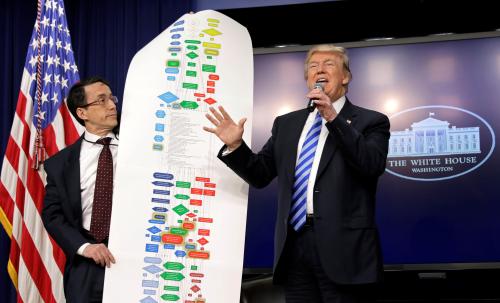A version of this post originally appeared in Devex.
The 21st century famously marks the first time in human history that the majority of people live in urban areas, yet this phenomenon is far from consistent across the planet. While urban areas in developed countries have seen significant slowdowns in their population expansion, it is rapid growth in the cities and suburbs of emerging economies that flipped the scales for the global population. Moving forward, emerging economies will occupy prime position in growing the global economy, expanding economic opportunity, and protecting the environment.
As emerging economies experienced rapid urban population growth, the private sector across the world continued to develop innovative digital technologies. Today, we stand at the exciting precipice of a digitally-connected built environment, or the smart city: the diffuse installation of connected digital sensors to better manage our urban areas.
These mega trends meet around the topic of environmental resilience. While exploding urban populations already put enormous pressure on the surrounding natural environment — ranging from global climate change to the loss of natural habitat at the neighborhood scale — smart city programs could mitigate these concerns and put humanity on a path to more sustainable urban growth. However, most smart city efforts focus on sales and integration within developed country contexts. To ensure that the smart city approach can deliver the greatest impact to the global economy, it is crucial to develop platforms that will address the specific problems of cities in developing country contexts — which show high vulnerability to environmental stressors, but strained public fiscal capacity and poor planning.
This is what makes India’s Smart Cities Mission such a pivotal effort. Launched under Prime Minister Narendra Modi in 2015, it is an ambitious multiyear effort to boost economic development, technological innovation, and sustainable growth across 109 Indian cities. Cities will employ a variety of measures to achieve this goal, including urban renovation, a push for compact mixed-use growth, sustainable retrofitting and integration of IT infrastructure.If executed effectively, India can serve as a groundbreaking model for other emerging nations as they embark upon their own smart city projects. Based on our analysis of the multiyear project so far, there are still many opportunities to address resilience in more robust and integrated ways.
Robust resilience focus needed
With a projected $15 billion investment ($7.5 billion from the national government with a matching contribution from state governments), the Smart Cities Mission represents one of the largest capital investments in emerging markets’ urban capacity. A large proportion of this investment will go towards creating or supplementing existing infrastructure in both greenfield and brownfield sites. Thus, the mission is an unprecedented opportunity to endow India’s urban areas with the infrastructure that will prepare them for both chronic stressors such as population growth and urbanization, but also acute stressors, such as floods and drought due to climate change. This takes on special significance in light of the growing frequency of high impact weather events, whether coastal flooding in Mumbai or drought in monsoon-dependent agricultural basins.
Due to the high vulnerability of dense urban areas, the potential impact of such events in terms of the loss of life and socio-economic costs can be a devastating blow to the economy. Against the backdrop of India’s active participation in COP22, the smart cities mission provides a potential pathway to address the vulnerabilities of India’s cities and to prepare them for the challenges that climate change will inevitably bring. Leveraging technology and data, cities can attempt to walk the delicate line between making their infrastructure environmentally resilient, while also promoting better socio-economic outcomes for their citizens and addressing urban fiscal health.
India’s smart city proposals: where things stand
Since the launch of the mission in 2015, the Indian government has chosen 60 winning smart city proposals over three rounds. However, there are still major questions as to whether each city’s unique proposal does enough to address long-term resilience concerns. To get at this concern, our team deep-dove into the first 20 city proposals chosen in Round 1 and assessed their plans to date. We found two critical issues.
First, the proposals lack a deliberate focus on resilience. During the proposal submission stage, India’s central government asked all competing cities to self-evaluate their baseline status across 24 pre-specified criteria, from water supply to walkability and citizen participation. Getting them right is therefore key to prioritizing the right projects; but the lack of a comprehensive focus on resilience, both from the perspective of “chronic” and “acute” stressors, leaves cities open to initiating projects that do not intentionally address their resilience challenges.
Second, the proposals do not sufficiently address basic service gaps. Basic infrastructure services — water supply, sanitation, solid waste management and energy — are the foundation upon which socio-economic growth rests. The gaps in India’s basic services have been established by literature in both academia and practice, and India’s Ministry of Urban Development even uses 28 Service Benchmark Indicators to promote core infrastructure development in water supply, sanitation, storm water drainage and solid waste management. However, the proposals are inconsistent in how they evaluate themselves and incomplete in the service categories they judge, even in comparison to MoUD’s own benchmarks.
Combined, these issues create a tempting platform for easier, more traditional projects. India thus runs the risk of deprioritizing long-term concerns in face of the ease of addressing short-term concerns through easily implementable — but ultimately less beneficial — projects. For instance, several cities take on solar LED lighting for streets as a project, which is a smart city standard with clear fiscal and environmental benefits. But, clarifying how this specific project takes precedence over others to meet the ultimate goal of energy efficiency can help decide is this is truly the right project for the city.
Making progress in India and beyond
While the Smart Cities Mission still leaves too many openings for questionable projects, there are opportunities to steer cities and their resulting project lists towards more of a focus on resilience. Here are three lessons for other emerging markets as they embark on a reform effort:
- Incorporate a robust resilience framework.
Indian cities can learn from an abundance of international best practices, including existing resilience frameworks such as the 100 Resilient Cities’ City Resilience Framework, OECD’s Resilient Cities Framework, the Rockefeller Foundation and RAND Corporation’s Resilience Dividend, UNISDR and UN-Habitat’s Handbook for Local Government Leaders, UNISDR’s Indicators for Local Risk Reduction and Resilience, and ACCRN’s Climate Vulnerability case studies for 3 Indian cities. While these frameworks use broader resiliency definitions that include economic and social contexts, they offer helpful lenses and are enriched by their global scope.
- Local smart city leadership needs to include rigorous and transparent project evaluations.
The only way to build public trust is to ensure citizens and private sector partners understand why specific projects earned selection and can contribute significantly to longer-term resilience efforts. This puts pressure on — the local, quasi-independent agencies leading local efforts — to both publicize their process and to ensure projects receiving investment are connected to a broader objective.
- Improve coordination and promote digital technology interventions.
Building on past umbrella initiatives such as JnNURM, and in conjunction with governmental schemes such as Basic Services for the Urban Poor, India will do well to identify the role of smart, digital technology in providing basic services. In addition, maintaining consistency with existing national benchmarks in the evaluation and implementation of specific city projects will bode well for a more comprehensive redressal of basic service issues.
There is no question that other emerging markets are watching. If implemented well, other places will see India’s approach of vertical governance coordination, quasi-private coordinating entities, transparency requirements, and objective prioritization as the way forward on resiliency solutions. In contrast, if the eventual India projects feel like giveaways to big technology companies and the rich, then the Indian model may stay in the subcontinent — to say nothing of the missed opportunities within Indian cities. Now is the perfect time to execute those reforms.
The Brookings Institution is committed to quality, independence, and impact.
We are supported by a diverse array of funders. In line with our values and policies, each Brookings publication represents the sole views of its author(s).







Commentary
Can India’s smart city proposals do more on resilience?
April 5, 2017